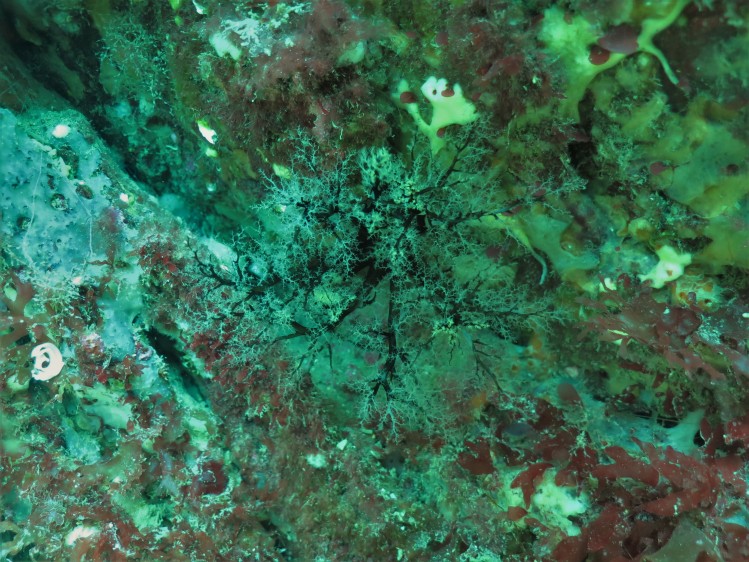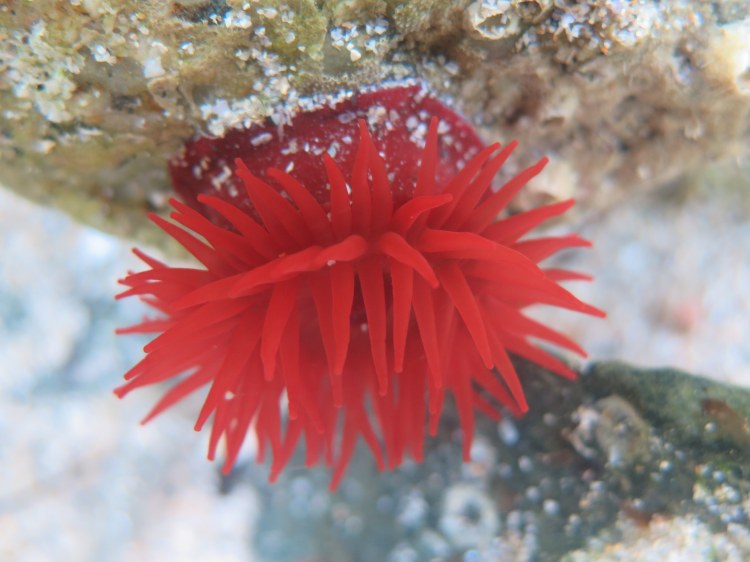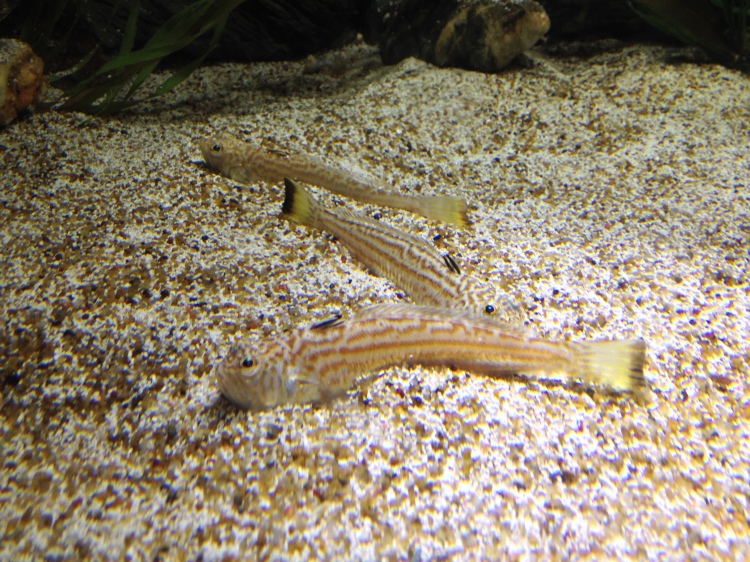 After seeing so many Sand smelt (Atherina presbyter) (EDIT or potentially Herring….very difficult to make out position of fins) schools from the local slip and quay in Flushing this week (see previous post), I went for a snorkel on Castle Beach in Falmouth over the weekend. Lots more were to be found! Below two clips. I have hardly shot any videos with my camera, and it unfortunately shows. Shaky camera movement and I forgot I had the option of shooting at a higher frame rate too, doh! I clearly need more practice. Each school consisted of fish of the same size (the smallest fish were around 3 cm and the largest maybe 9 cm), but when chased by a hapless snorkeller some merged temporarily. If you look closely, you can see about one in a hundred fish have a little bite taken out of them, I did not see any predators though.
After seeing so many Sand smelt (Atherina presbyter) (EDIT or potentially Herring….very difficult to make out position of fins) schools from the local slip and quay in Flushing this week (see previous post), I went for a snorkel on Castle Beach in Falmouth over the weekend. Lots more were to be found! Below two clips. I have hardly shot any videos with my camera, and it unfortunately shows. Shaky camera movement and I forgot I had the option of shooting at a higher frame rate too, doh! I clearly need more practice. Each school consisted of fish of the same size (the smallest fish were around 3 cm and the largest maybe 9 cm), but when chased by a hapless snorkeller some merged temporarily. If you look closely, you can see about one in a hundred fish have a little bite taken out of them, I did not see any predators though.
Tag Archives: Sand smelt
Whitebait
 This Friday at the Seven Stars pub in Flushing there was a lot of activity in the water. Huge shoals of Sand smelt Atherina presbyter ((EDIT or potentially Herring….very difficult to make out!) were chased up the slip by mackerel. The shoals were so dense you could scoop the fish out of the water with your hands and shed fish scales were shimmering everywhere. I quickly picked up my camera from home down the road and stuck it underwater. With the fading light (and two kids to take care of) the filming was hurried and not ideal, but still gave a nice view of the frantic activity.
This Friday at the Seven Stars pub in Flushing there was a lot of activity in the water. Huge shoals of Sand smelt Atherina presbyter ((EDIT or potentially Herring….very difficult to make out!) were chased up the slip by mackerel. The shoals were so dense you could scoop the fish out of the water with your hands and shed fish scales were shimmering everywhere. I quickly picked up my camera from home down the road and stuck it underwater. With the fading light (and two kids to take care of) the filming was hurried and not ideal, but still gave a nice view of the frantic activity.
more diving
 Last Wednesday I went for a quick dive at Silver Steps in Falmouth, good viz and the water is no longer cold. Buddy Chris (above) and I rummaged around the U-boat wreckage (less impressive than it sounds) and unfortunately did not see any cuttlefish. What was new was a largish Topknot Zeugopterus punctatus which was gone before I could take a decent photo. I also saw seacucumbers for the first time diving (have seen them before when rock pooling, including parasitic snails). They could be Pawsonia or Aslia, but with the bodies wedged in the rocks and only the feeding tentacles visible it is not possible to tell. Sand eels were abundant and Sand smelt Atherina presbyter were also present at the surface. I hope to go back soon to practice with the strobe. I did a second dive in Flushing with Thomas too. Enjoyable but not too many great shots. I included one of Sand mason worms Lanice conchilega and fan worms Megalomma vesiculosum.
Last Wednesday I went for a quick dive at Silver Steps in Falmouth, good viz and the water is no longer cold. Buddy Chris (above) and I rummaged around the U-boat wreckage (less impressive than it sounds) and unfortunately did not see any cuttlefish. What was new was a largish Topknot Zeugopterus punctatus which was gone before I could take a decent photo. I also saw seacucumbers for the first time diving (have seen them before when rock pooling, including parasitic snails). They could be Pawsonia or Aslia, but with the bodies wedged in the rocks and only the feeding tentacles visible it is not possible to tell. Sand eels were abundant and Sand smelt Atherina presbyter were also present at the surface. I hope to go back soon to practice with the strobe. I did a second dive in Flushing with Thomas too. Enjoyable but not too many great shots. I included one of Sand mason worms Lanice conchilega and fan worms Megalomma vesiculosum.




End of Year Pics
I have not posted as much on the blog as I would have liked this year (in fact, I keep posting less and less: 24 times this year, compared with 33, 46 and 64 posts the previous years). My new year’s resolutions will be to dive more, to go rock pooling more and to blog more. For now, I will post some miscellaneous photos from this year that I did not bother to put on the blog at the time (as I did last year). Below a Beadlet anemone Actinia equina on the beach in St. Ives as well as a young cormorant looking for food taken with my new Canon G16:
 I caught a number of different fish this year, the first photo shows a small Montagu’s blenny Coryphoblennius galerita in an aquarium net which were fun to watch in a little aquarium. Next a Longspined scorpionfish Taurulus bubalis caught with my big net off the quay and a Sand smelt Atherina presbyter (see here for a movie). The latter species did not last long in my tank unfortunately. I mentioned in the last aquarium update that a Topknot I caught seemed to have died in the tank too, but I found out it is still there, it just likes to hide behind the rocks.
I caught a number of different fish this year, the first photo shows a small Montagu’s blenny Coryphoblennius galerita in an aquarium net which were fun to watch in a little aquarium. Next a Longspined scorpionfish Taurulus bubalis caught with my big net off the quay and a Sand smelt Atherina presbyter (see here for a movie). The latter species did not last long in my tank unfortunately. I mentioned in the last aquarium update that a Topknot I caught seemed to have died in the tank too, but I found out it is still there, it just likes to hide behind the rocks.

 I visited the quirky Victorian Horniman Museum and Aquarium on a trip to London which features lots of stuffed animals and diorama’s which I find quite fascinating. The aquarium part is small; there is some behind the scene coral (sexual) propagation research going on which sounds very interesting. There were two or three coldwater tanks too, the larger tanks were not much too look at (I know how hard it is…) but I really liked the Victorian fountain-style aquarium. A quick snap here; see this video for a nice overview. I would like to collect some Black brittlestars Ophiocomina nigra next year, they can be very abundant at slightly deeper sites.
I visited the quirky Victorian Horniman Museum and Aquarium on a trip to London which features lots of stuffed animals and diorama’s which I find quite fascinating. The aquarium part is small; there is some behind the scene coral (sexual) propagation research going on which sounds very interesting. There were two or three coldwater tanks too, the larger tanks were not much too look at (I know how hard it is…) but I really liked the Victorian fountain-style aquarium. A quick snap here; see this video for a nice overview. I would like to collect some Black brittlestars Ophiocomina nigra next year, they can be very abundant at slightly deeper sites. I also visited the National Marine Aquarium in Plymouth for a second time. It features the deepest aquarium in the UK, complete with plane wreck and some Sandtiger sharks. I was more interested in the coldwater stuff, of which there was quite a bit. I especially liked the Lesser weever Echiichthys vipera which can be caught on sandy shores; their venomous sting would make handling a bit tricky though. There were some cute pipefish (these need live food and I do not want to commit to that) and a round display with loads of Snakelocks anemones (see the first picture posted on this blog). I have placed a couple of these in my aquarium again, perhaps I need to get a few more, as they are so pretty and easy to keep. I did not manage to get a good shot of the very impressive Wreck fish or Stone bass Polyprion americanus in the large coldwater display unfortunately.
I also visited the National Marine Aquarium in Plymouth for a second time. It features the deepest aquarium in the UK, complete with plane wreck and some Sandtiger sharks. I was more interested in the coldwater stuff, of which there was quite a bit. I especially liked the Lesser weever Echiichthys vipera which can be caught on sandy shores; their venomous sting would make handling a bit tricky though. There were some cute pipefish (these need live food and I do not want to commit to that) and a round display with loads of Snakelocks anemones (see the first picture posted on this blog). I have placed a couple of these in my aquarium again, perhaps I need to get a few more, as they are so pretty and easy to keep. I did not manage to get a good shot of the very impressive Wreck fish or Stone bass Polyprion americanus in the large coldwater display unfortunately. 

 Next up a washed up sponge in Falmouth (species unknown) and a live one (Aplysilla sulfurea) under a rock, both taken in Falmouth with my iPhone. I have only been diving a couple of times this year and did not post about the rocky shore dives (here some photos of the maerl and eelgrass beds). I have seen a variety of interesting animals, including cuttlefish, a conger eel and lobsters but next year I hope to go out a bit further and dive a bit deeper to finally see jewel anemones and dead man’s fingers. I am not sure I want to commit to a flash and strobes though, instead I’d like to practice my rock pool (seaweed) photography.
Next up a washed up sponge in Falmouth (species unknown) and a live one (Aplysilla sulfurea) under a rock, both taken in Falmouth with my iPhone. I have only been diving a couple of times this year and did not post about the rocky shore dives (here some photos of the maerl and eelgrass beds). I have seen a variety of interesting animals, including cuttlefish, a conger eel and lobsters but next year I hope to go out a bit further and dive a bit deeper to finally see jewel anemones and dead man’s fingers. I am not sure I want to commit to a flash and strobes though, instead I’d like to practice my rock pool (seaweed) photography. 





More Pontooning
Went back today for some more peering from the pontoons in Mylor Bridge marina. Besides the Thicklipped mullet and Two-spotted gobies, small schools of Sand smelt Atherina presbyter were out and about. A short clip of this silvery, pretty fish made using the Canon Powershot 30D and after that a clip made with a GoPro 3+ (not in HD as it was my 2nd, free upload)):
(Annoying that wordpress makes the 2nd clip smaller!) I managed to find back the single 1 cm Elegant anemone Sagartia elegans mentioned in the last post but again was unable to remove it; seems like this species knowns how to attach itself a bit better than do Plumose anemones. I noticed that besides the tunicates, sponges, bivalves (mussels and oysters), seaweeds, anemones and peacock worms, hydroids and bryozoans are also very abundant. I still have to educate myself a bit about these groups. The peacock worms would be beautiful for the aquarium. Although they would be easy to dislodge, it would be problematic to fasten them to something again. Maybe I’ll find a small object with some attached when I’m diving that I could take back some time (frozen artemia might be too big for them to eat, so I would need to look at artifical plankton products for food).



